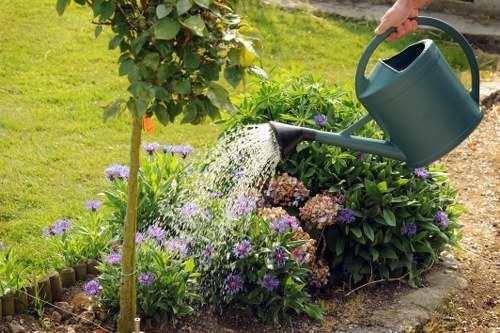Grass Cutting in Garden Maintenance
Introduction to Grass Cutting and Its Vital Role in Garden Maintenance

Grass cutting is more than a simple chore—it is an essential aspect of garden maintenance that ensures your outdoor spaces remain beautiful, healthy, and inviting. In modern garden upkeep, proper grass cutting practices not only enhance the visual appeal of lawns but also contribute significantly to the overall vitality of your garden ecosystem. Regular trimming encourages dense turf growth, helps control weeds, and allows for better air circulation and sunlight penetration, which are critical factors for robust lawn health. When you invest your time or professional service in mowing, you are not only maintaining the aesthetics of your garden but also providing a necessary service that promotes environmental balance. Maintaining a lush green lawn can transform any garden into a relaxing retreat, and our insights into grass cutting techniques are designed to assist both beginners and seasoned gardeners alike.
Effective lawn care begins with selecting the right equipment and learning how to use it properly. Whether you are using a reel mower, rotary mower, or an electric model, understanding the mechanics behind each tool is key to achieving the best results. For instance, using a mower that is too heavy or dull can damage your grass, while well-maintained equipment provides a clean cut that minimizes stress on the plants. Situating the right gear in the context of your garden's size, terrain, and grass type is imperative to harness the benefits of regular grass cutting. With smart planning, every cut can deliver a healthier, aesthetically pleasing lawn, making your garden a source of pride.
Beyond practical benefits, routine grass cutting also serves as a preventative measure against pests and diseases. A well-kept lawn is less prone to infestations, as shorter grass discourages the buildup of harmful insects and fungal growth. Moreover, the regular process of trimming your grass is an opportunity to observe changes in your landscape and detect any early signs of problems. Cultivating a habit of consistent maintenance can help identify issues before they escalate, ensuring that your garden remains a safe and serene environment. This detailed approach to grass cutting in garden maintenance not only conserves the health of your turf but also upholds the overall integrity and visual charm of your outdoor sanctuary.
Techniques and Equipment for Effective Lawn Mowing

Understanding lawn mowing techniques involves knowing the various methods that optimize grass cutting efficiency. Different grass types and terrain conditions may necessitate unique approaches, such as adjusting the mower's height or changing the cutting pattern. A common practice is to alternate the mowing direction with each session, reducing soil compaction and ensuring that the grass blades are cut evenly. In addition, incorporating advanced techniques like mulching mow can recycle nutrients back into the soil, thereby bolstering the health of your garden. Whether living in an urban setting or a rural haven, applying these lawn mowing strategies can yield noticeable results in the vibrancy of your outdoor space.
Alongside various techniques, the selection of equipment is paramount to efficiency. Smart equipment choices range from manual reel mowers to advanced robotic mowers, each suited for different scales and preferences. For smaller gardens, a lightweight electric mower offers ease and efficiency, while larger lawns benefit from gas-powered models that cover vast areas quickly. Regular maintenance of these machines is equally critical; a well-oiled and sharp blade not only ensures precision but also preserves the health of the grass by reducing ragged cuts which can invite disease. Professionals often recommend that homeowners check their equipment seasonally, thereby preventing minor issues from becoming major setbacks.
Integrating quality grass cutting techniques with the right equipment can lead to transformative results for your garden. For example, professional-grade mowers often incorporate innovative features like adjustable cutting heights, ergonomic designs, and eco-friendly operation, ensuring that users can maintain their lawns with ease and safety. Safety and functionality are core elements in the effective use of any gardening tool, and continuous learning about new advancements in mowing technology can contribute to a smarter, more sustainable garden maintenance routine. In doing so, you harness the best of both worlds: traditional care with modern advancements geared toward greener, more precise lawn care.
Enhancing Safety and Environmental Benefits in Grass Cutting

Grass cutting is not merely an aesthetic enhancement; it offers significant benefits for safety and environmental protection. Regularly trimmed grass reduces the likelihood of accidents by clearing obscured pathways and providing a safer environment for both children and the elderly. Additionally, a well-maintained lawn minimizes the habitat for pests and rodents which tend to thrive in overgrown areas. Preventive measures, such as checking for hidden objects under the grass, are essential for avoiding injuries and property damage. By fostering a clean, secure, and sustainable garden environment, homeowners can simultaneously boost their curb appeal while safeguarding family members and visitors.
From an environmental standpoint, the practice of proper grass cutting has several sustainable benefits. When grass is cut at the optimal height, it promotes root growth and fortifies the lawn against drought and heat stress, thereby reducing the need for excessive watering and chemical treatments. Many eco-friendly mowing techniques also focus on mulching, which naturally recycles grass clippings into nutrient-rich compost, reducing waste while enhancing soil fertility. This recycling process is not only beneficial for plant health but also decreases greenhouse gas emissions typically associated with lawn care. Embracing these responsible methods underlines the importance of integrating environmental considerations with everyday garden maintenance routines.
Another vital aspect of safety in garden maintenance includes proper equipment handling and protective measures. Gardeners are encouraged to wear safety gear such as gloves, goggles, and sturdy footwear, which help prevent injuries during mowing. Routine checks of the mower and associated tools are critical, and most manufacturers advise regular maintenance schedules to ensure all safety features function correctly. Additionally, planning a mowing schedule that considers weather conditions and the moisture level of the grass can further minimize risks. The focus on safety, when combined with environmental mindfulness, positions grass cutting as a holistic practice that benefits both individuals and nature, promoting a balanced and flourishing garden space.
Maintenance Routines and Scheduling for Lush, Green Lawns

Establishing a consistent maintenance routine is crucial to achieving a healthy, vibrant garden. Timely grass cutting sessions ensure that the lawn retains a uniform look and prevents overgrowth that could lead to weed invasion. Experts suggest mowing once a week during the peak of the growing season, though this can vary depending on local climate conditions and the type of grass. An effectively scheduled mowing routine not only maintains the green appearance but also leads to less stress on the grass, which in turn promotes faster recovery and thicker growth. Gardeners should consider the best time of day to mow as well, typically when the grass is dry, to ensure a precise and clean cut without clumping or uneven patches.
For many homeowners, formulating a garden maintenance calendar that includes regular grass cutting sessions, fertilization, and even aeration can be challenging yet highly rewarding. Incorporating tools like planners or digital apps to track maintenance tasks helps in staying on top of your gardening responsibilities. In addition, using rain forecasts to adjust your mowing schedule can prevent issues related to wet grass, which is more prone to disease and damage from dull blades. Effective scheduling builds a robust foundation for maintaining a top-notch lawn that is both visually appealing and resilient to seasonal challenges.
Exploring innovative methods in routine garden care, such as integrating robotics with traditional lawn maintenance or even participating in local community gardening initiatives, can also be beneficial. Many consider a balance between manual labor and professional support as the key to sustainable gardening. Whether you prefer a do-it-yourself approach or opt for professional services, ensuring that your grass cutting practices are part of a broader, well-planned maintenance program is crucial. Remember to contact us today for tailored advice or to book your service now if you feel the process requires expert handling, as timely intervention can make all the difference in preserving your garden’s lush appeal.
DIY Versus Professional Grass Cutting: Making the Most Informed Choice

When considering grass cutting in garden maintenance, one of the most frequent decisions gardeners face is whether to tackle the task themselves or hire a professional service. Each approach comes with its benefits and challenges. Homeowners who prefer a DIY approach often relish the opportunity to connect with their garden and exercise complete control over the mowing process. However, this method demands time, a proper understanding of grass care techniques, and consistent upkeep of equipment. In contrast, professional lawn care services provide a reliable solution with advanced tools, leading to precise cuts and tailored maintenance schedules that suit the unique conditions of each garden.
For those leaning towards DIY grass cutting, the satisfaction of a well-manicured lawn can be immensely rewarding. Yet, recent trends have shown that many homeowners are increasingly outsourcing this task to experts to ensure that the job is done quickly and efficiently. Professionals not only bring specialized knowledge but also handle other aspects of garden maintenance, such as fertilization and pest control. The convenience of delegating these responsibilities allows homeowners to enjoy a pristine lawn without the extensive commitment of time and labor. Moreover, accessing expert advice can be particularly helpful for beginners who are unfamiliar with the intricacies of outdoor upkeep. Book your service now if you prefer a hassle-free experience that guarantees a beautifully maintained garden all year round.
Ultimately, the decision between DIY and professional services depends on personal circumstances, budget, and preferences. Both approaches share the common goal of creating a healthy and attractive landscape, yet a hybrid model that combines self-effort with occasional professional interventions can often yield the best results. Notably, investing in both methods can create a dynamic regimen of care where seasoned expertise complements hands-on efforts. Many find that such a balance not only conserves personal energy but also produces a consistently remarkable lawn. For those seeking long-term garden wellness and detailed maintenance, the integration of professional services at strategic intervals may prove invaluable. Embracing flexibility in your lawn care routine can lead to continuous improvement and pristine outdoor spaces, making every moment spent in your garden truly inspiring.

